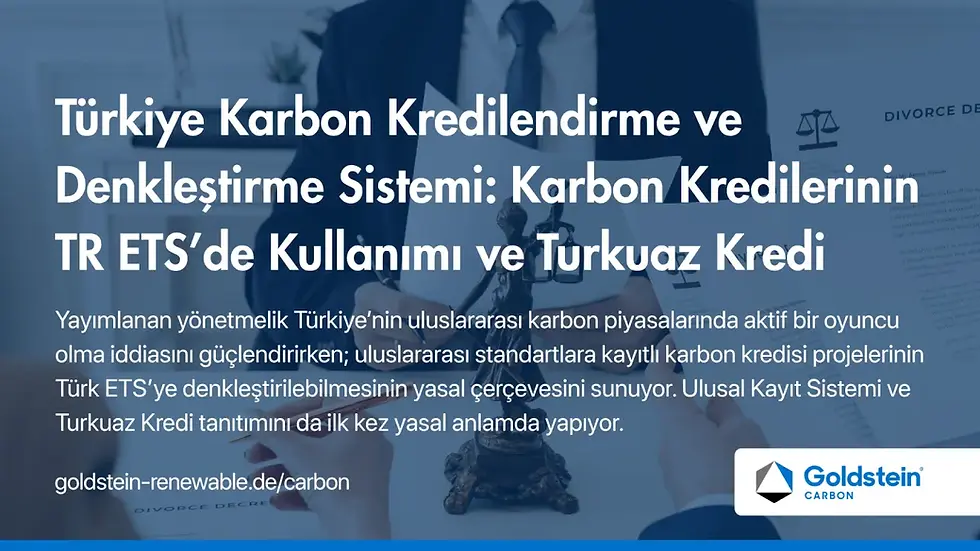From Kyoto to Paris: 30 Years of Carbon Market Evolution
- Goldstein Carbon

- Jul 10
- 3 min read

Initial Global Steps
The impact of greenhouse gases, especially carbon dioxide, on global warming was widely accepted in scientific literature by the late 20th century. Since the Industrial Revolution—approximately the past 150 years—cumulative emissions from human activities have significantly increased, causing a notable rise in global average temperatures. There has been global scientific consensus on the risks posed by this trend.
The first major step in this context was the signing of the United Nations Framework Convention on Climate Change (UNFCCC) in 1992 under the UN. This framework laid the groundwork for limiting global greenhouse gas emissions and formed the basis for the methodologies and policy tools used today. However, the agreement lacked binding targets, creating the need for enforceable emission reduction goals.
Toward Binding Targets: The Kyoto Protocol
In response, the Kyoto Protocol was adopted at COP3 in Kyoto, Japan in 1997. It was the first international treaty to set legally binding emission reduction targets for developed countries. However, it only entered into force in 2005.
The first commitment period under Kyoto spanned 2008–2012, targeting an average 5% reduction below 1990 levels for developed nations. Unfortunately, these targets were largely unmet. While important in theory, the protocol had limited real-world impact on emissions.
Post-2012: Shift to Regional Systems
The industry expected a new global agreement to follow the end of the Kyoto commitment period in 2012, including countries like China and the USA, and anticipated Turkey's active participation. This optimism influenced investments and planning between 2009–2012.
However, no agreement was reached at the 2012 COP summit, and Kyoto’s first commitment period ended without a new treaty or negotiation process. This led to the collapse of international emission reduction obligations.
Carbon markets suffered a major setback. The EU continued its Emissions Trading System (EU ETS), while new regional systems like California’s emerged. Yet, there was no global mandatory carbon market.
The 2008 global financial crisis also deeply affected Europe by 2010–2012. Factory closures and reduced operations lowered emissions, reducing demand for offsets and creating a (surplus) of carbon credits. Prices collapsed—from €15 to as low as €0.30.
In response, the EU decided to remove and cancel about 1.5 billion surplus credits from the market in 2013–2014 to revive prices. This “burn” operation aimed for gradual recovery, but impact was limited—prices only rose to €1–2.
Momentum Renewed with the Paris Agreement
In 2015, the UN took a major step toward a new global deal. A pre-agreement was made before the Paris summit, which boosted market sentiment, though it wasn’t legally binding.
In 2016, the Paris Agreement was officially signed. Yet, its implementation was slow. Many articles, including the critical (Article 6) defining market rules, were only finalized by 2021.
Unlike Kyoto’s unrealistic 5% targets, the Paris deal proposed more feasible goals like 50% reduction vs. 1990 by 2030 and (90% by 2050) to keep warming below 2°C.
Pandemic, War, and Macroeconomic Pressures
Just as momentum returned, the COVID-19 pandemic hit in 2020, shifting global priorities. Carbon markets paused again during this two-year period.
Markets rebounded in 2021 as pandemic effects faded. For the first time, carbon prices surged significantly, and the EU ETS hit €100—a level considered the upper penalty threshold.
Voluntary carbon prices also varied by project quality, ranging €5–10, with some projects reaching €20.
But in 2022, the Russia–Ukraine war introduced new uncertainties. High inflation and geopolitical tension began to weigh on carbon markets.
Although carbon credits behave like commodities with internal market drivers, they’re treated as risk assets. In high interest rate environments, their value drops—just like other volatile assets.
Now, as global interest rates begin to fall again, carbon markets show early signs of recovery. The trend is modest but clearly positive.



Comments